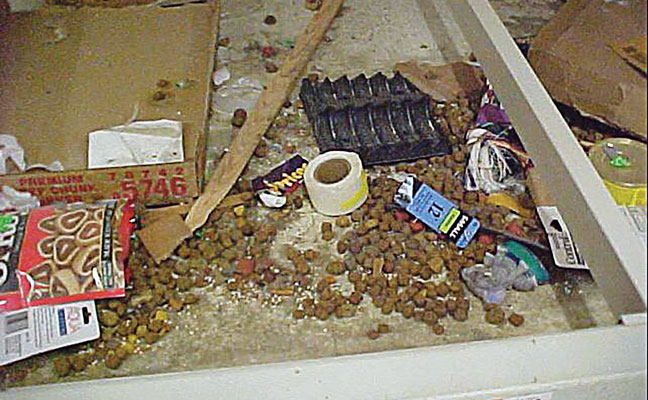
Food can quickly accumulate behind a kickplate in a retail setting. PHOTO: INSECTS LIMITED
The term stored product pests (SPP) encompasses many insects, including Indianmeal moths (Plodia interpunctella), warehouse beetles (Trogoderma variabile), cigarette beetles (Lasioderma serricorne), drugstore beetles (Stegobium paniceum), confused flour beetles (Tribolium confusum), sawtoothed grain beetles (Oryzaephilus surinamensis), and red-legged ham beetles (Necrobia rufipes), among others. They also are frequent pests of dried food goods in retail settings.
Food products stocked on retail shelves are in their last stop before moving into consumers’ homes. In this crucial stage of the supply chain, retail shop owners need to make sure those foods look attractive on the shelf while being free of pests. Unfortunately, many SPP use this opportunity to feed on dried food products that have been sitting on a shelf for too long. They also use retail settings as a golden opportunity to move from one type of food to the next as food items sit side-by-side on the shelf.

Pat Kelley, president, Insects Limited
If an infestation occurs, the consumer most likely will arrive home before they discover that insects are feeding on the products they just purchased. As a knee-jerk reaction, many folks immediately take to social media to shame the manufacturer and the retail chain alike, with pest images and scalding words that quickly get lots of views.
Protecting a brand is becoming more and more difficult for all companies involved, including the pest management professionals (PMPs) who service retail accounts. To prevent consumers from ever finding bugs in their dried food goods in the first place, consider the following five tips:
1. Assign an IPM administrator with the knowledge and ability to make decisions. There should be a point person in place who knows something about insect pests, food damage and brand protection to be accountable for any and all pest activity within the retail store. This person needs to be able to guide an integrated pest management (IPM) program and make critical pest-related decisions. This person could be a store manager, or a lead pest management technician on the account. But if one person doesn’t take responsibility for preventing pests, no one will take responsibility for preventing them — and pest outbreaks will occur.
2. Have the shipment managers inspect incoming materials for obvious signs of SPP. One of the easiest ways for these damaging insects to gain access to a store is through incoming product that already is infested. As delivery trucks arrive daily, the people who are responsible for accepting incoming shipments should have training on what the signs of pest activity look like. They should be given a good flashlight to check for insects beneath the shrink wrap on palletized material; look for pupating moths in the folded ends of pet food bags; and discover any insect frass, bag damage, and visible beetles or moths on the product. Any infested materials should be rejected and should not be allowed to enter the store, as infestations quickly can become store-wide.
3. Monitor susceptible items. Monitoring is an essential part of preventing pest outbreaks in retail settings. Monitoring traps can indicate whether pests are present, where they may be coming from, and whether the treatment options you used to get rid of the pests are working. Species-specific pheromone traps are designed to use the insect’s own biology and means of communication against it. Place monitors near the most susceptible products, and ensure they are checked at least on a monthly basis. If you can get stockroom, and shipping and receiving employees to record any sightings in a logbook between visits, so much the better.
4. Provide a detailed cleaning beneath retail shelving and in storage areas. One of the most common SPP sources in retail settings are the areas beneath retail shelves or in back storage areas where the packaging of dried food goods has been broken open and the contents spilled out and never cleaned up. When a bag of pet food breaks open while being stocked on the shelf, or when a customer roughly grabs it and accidentally tears it open, pieces of kibble often fall behind the shelving and end up in an unseen area on the floor, behind the kick plate in the aisle. Once this food is out of sight, it is often out of mind for the cleaning crews. The food product sits in this dark, protected area until a lucky SPP stumbles across it and finds that this is the perfect environment in which to raise a family. Whether done in-house or offered as a service by the PMP, a detailed inspection and cleaning of these hard-to-reach or overlooked areas should be performed on at least a quarterly basis to break up the insect life cycle.
5. Train everyone to be on the lookout for pests. The more trained eyes that are out there looking for pests, the better the chances are of preventing pest outbreaks. As previously stated, if the staff members who accept incoming loads of product on delivery trucks know what SPP look like, and know their telltale signs, they can reject infested shipments before any infested product is unloaded into the store. Stockers can recognize in-store insect issues to pass along to management or the PMP. Store clerks can pass along information about moths flying or beetles crawling around the checkout area. Every employee should be exposed to some degree of pest training during their onboarding process. All these folks with “boots on the ground” in the retail setting are in a position to give some of the most valuable IPM feedback. Without some training, though, the information will never make it to the person who makes the pest control decisions, and pest populations will continue to grow until real issues start to happen. This ounce of prevention definitely will translate into a pound of cure.
Leave A Comment